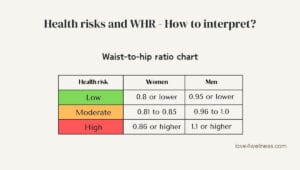Body Mass Index, shortly known as BMI, is a measure that denotes if a person has a healthy weight. Since obesity is considered a risk factor for many diseases, BMI is used as a metric to predict an individual’s risk of health conditions. However, health experts argue that BMI is flawed and may not be accurate for all ethnicities, races, and genders. In addition, wellness experts suggest the waist-to-hip ratio to be a better predictor of an individual’s health.
Body mass index (BMI) that considers excess weight as body fat
Body fat is a crucial factor in overall wellness, and excess body fat is cited as a risk factor for several chronic health conditions, including diabetes, heart disease, Alzheimer’s, etc.

For several decades, health experts used BMI, a formula that uses height and weight to determine body fat, to assess a person’s risk for health conditions. However, according to a post in the Montreal Gazette, criticism is growing that BMI is a “crude, flawed, and overrated proxy for health”.
Formula to find BMI: BMI = Weight in kilograms / (Height in metres)²
BMI is a flawed metric. Why?
Experts argue that BMI was developed based on white males and has little validity for other racial and ethnic groups. Also, BMI does not consider how much body fat vs muscle a person has and which part of the body the weight distribution is in.
BMI neither distinguishes between bone mass, excess fat, or muscle mass nor considers which part of the body the excess weight is distributed.
Where is your weight concentrated? Why is this important?
Not all weight poses health risks. You can be obese, but without at risk for a health condition. You can be of normal weight, but still might be at risk of certain health conditions.
For example, apple-shaped people carrying more weight in the abdomen have a high risk of heart disease, diabetes, etc. This is because abdominal fat, also called visceral fat, increases insulin resistance, leading to various adverse conditions.
On the other hand, pear-shaped people with more weight spread in the hip and buttocks have a lower risk of such diseases.
Hence, BMI, the standard to measure health in a person, is no longer considered an accurate health marker.
More Posts You May Like
Waist-to-hip ratio – a better alternative to BMI
The waist-to-hip ratio is hence considered more accurate in predicting health outcomes in people.
How to measure?
- Measure the smallest circumference just above your belly button. This is the waist circumference.
- Measure the widest part of your hip. This is your hip circumference.
Formula to find WHR: Waist-to-Hip Ratio (WHR) = Waist circumference / Hip circumference
Waist-to-hip ratio chart

Typically, a WHR less than 0.85 for women and less than 1.0 for men is healthy.
What are some negative consequences of using BMI?
Wrong diagnosis
Doctors may sometimes attribute an individual’s health condition to excessive weight, or they may overlook diagnosing a condition when a person has a healthy BMI. This can lead to incorrect diagnoses and delays in treatment.
For instance, athletes or boxers may have a higher BMI due to their muscular build. But this weight is healthy and does not pose any risk to their health. However, BMI assumes excess weight as fat, which may lead to incorrect diagnoses.
Moreover, certain ethnic groups, such as the Japanese and Taiwanese, have a higher risk of diabetes even if their BMI falls within the healthy range. Therefore, clinicians who rely too heavily on BMI as a measure of health may make incorrect diagnoses and delay necessary treatments.
Patients mistrust on doctors
Suppose there is an individual who is otherwise healthy but obese. Their doctor advises them to lose weight. But if they do, they may feel sick because they feel well with their current weight. In such a situation, the patient may lose trust in their doctor.
Delay in seeking treatment
Patients sometimes assume that their declining health is due to an unhealthy BMI, and they may try to address it through self-care to achieve a healthier weight. However, the underlying cause of their health condition may not be related to weight at all and could be something entirely different. This can lead to the patient delaying seeking a medical diagnosis, which in turn delays the start of treatment.
The bottom line
Several studies acknowledge that the Waist-to-hip ratio (WHR) better predicts health risks than BMI. BMI does not differentiate between fat, muscle, and bone mass and is inaccurate among certain ethnicities, races, and genders. So, rely on inch tape rather than on the scales to assess your overall health.
Images: canva.com
